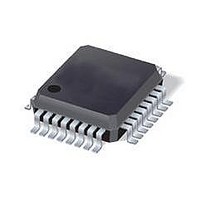C8051F350 Silicon Laboratories Inc, C8051F350 Datasheet - Page 149

C8051F350
Manufacturer Part Number
C8051F350
Description
IC 8051 MCU 8K FLASH 32LQFP
Manufacturer
Silicon Laboratories Inc
Series
C8051F35xr
Specifications of C8051F350
Core Processor
8051
Core Size
8-Bit
Speed
50MHz
Connectivity
SMBus (2-Wire/I²C), SPI, UART/USART
Peripherals
POR, PWM, Temp Sensor, WDT
Number Of I /o
17
Program Memory Size
8KB (8K x 8)
Program Memory Type
FLASH
Ram Size
768 x 8
Voltage - Supply (vcc/vdd)
2.7 V ~ 3.6 V
Data Converters
A/D 8x24b; D/A 2x8b
Oscillator Type
Internal
Operating Temperature
-40°C ~ 85°C
Package / Case
32-LQFP
Data Bus Width
8 bit
Data Rom Size
128 B
On-chip Adc
10 bit
Number Of Timers
16 bit
Operating Supply Voltage
2.7 V to 3.6 V
Mounting Style
SMD/SMT
Height
1.4 mm
Length
7 mm
Maximum Operating Temperature
+ 85 C
Minimum Operating Temperature
- 40 C
Width
7 mm
Lead Free Status / RoHS Status
Contains lead / RoHS non-compliant
Eeprom Size
-
Lead Free Status / Rohs Status
No RoHS Version Available
Available stocks
Company
Part Number
Manufacturer
Quantity
Price
Company:
Part Number:
C8051F350
Manufacturer:
Silicon Laboratories Inc
Quantity:
10 000
Part Number:
C8051F350
Manufacturer:
SILICON LABS/芯科
Quantity:
20 000
Company:
Part Number:
C8051F350-GQ
Manufacturer:
SiliconL
Quantity:
3 029
Company:
Part Number:
C8051F350-GQ
Manufacturer:
SILICON
Quantity:
18
Company:
Part Number:
C8051F350-GQ
Manufacturer:
Silicon Laboratories Inc
Quantity:
10 000
Company:
Part Number:
C8051F350-GQR
Manufacturer:
Silicon Laboratories Inc
Quantity:
10 000
Part Number:
C8051F350-GQR
Manufacturer:
SILICON LABS/芯科
Quantity:
20 000
Company:
Part Number:
C8051F350DK
Manufacturer:
SiliconL
Quantity:
8
Company:
Part Number:
C8051F350R
Manufacturer:
Silicon Laboratories Inc
Quantity:
10 000
C8051F350/1/2/3
19.3. SMBus Operation
Two types of data transfers are possible: data transfers from a master transmitter to an addressed slave
receiver (WRITE), and data transfers from an addressed slave transmitter to a master receiver (READ).
The master device initiates both types of data transfers and provides the serial clock pulses on SCL. The
SMBus interface may operate as a master or a slave, and multiple master devices on the same bus are
supported. If two or more masters attempt to initiate a data transfer simultaneously, an arbitration scheme
is employed with a single master always winning the arbitration. Note that it is not necessary to specify one
device as the Master in a system; any device who transmits a START and a slave address becomes the
master for the duration of that transfer.
A typical SMBus transaction consists of a START condition followed by an address byte (Bits7-1: 7-bit
slave address; Bit0: R/W direction bit), one or more bytes of data, and a STOP condition. Each byte that is
received (by a master or slave) must be acknowledged (ACK) with a low SDA during a high SCL (see
Figure 19.3). If the receiving device does not ACK, the transmitting device will read a NACK (not acknowl-
edge), which is a high SDA during a high SCL.
The direction bit (R/W) occupies the least-significant bit position of the address byte. The direction bit is set
to logic 1 to indicate a "READ" operation and cleared to logic 0 to indicate a "WRITE" operation.
All transactions are initiated by a master, with one or more addressed slave devices as the target. The
master generates the START condition and then transmits the slave address and direction bit. If the trans-
action is a WRITE operation from the master to the slave, the master transmits the data a byte at a time
waiting for an ACK from the slave at the end of each byte. For READ operations, the slave transmits the
data waiting for an ACK from the master at the end of each byte. At the end of the data transfer, the master
generates a STOP condition to terminate the transaction and free the bus. Figure 19.3 illustrates a typical
SMBus transaction.
SCL
SDA
SLA6
SLA5-0
R/W
D7
D6-0
START
Slave Address + R/W
ACK
Data Byte
NACK
STOP
Figure 19.3. SMBus Transaction
19.3.1. Arbitration
A master may start a transfer only if the bus is free. The bus is free after a STOP condition or after the SCL
and SDA lines remain high for a specified time (see
Section “19.3.4. SCL High (SMBus Free) Timeout” on
page
150). In the event that two or more devices attempt to begin a transfer at the same time, an arbitra-
tion scheme is employed to force one master to give up the bus. The master devices continue transmitting
until one attempts a HIGH while the other transmits a LOW. Since the bus is open-drain, the bus will be
pulled LOW. The master attempting the HIGH will detect a LOW SDA and lose the arbitration. The winning
master continues its transmission without interruption; the losing master becomes a slave and receives the
rest of the transfer if addressed. This arbitration scheme is non-destructive: one device always wins, and
no data is lost.
Rev. 0.4
149











